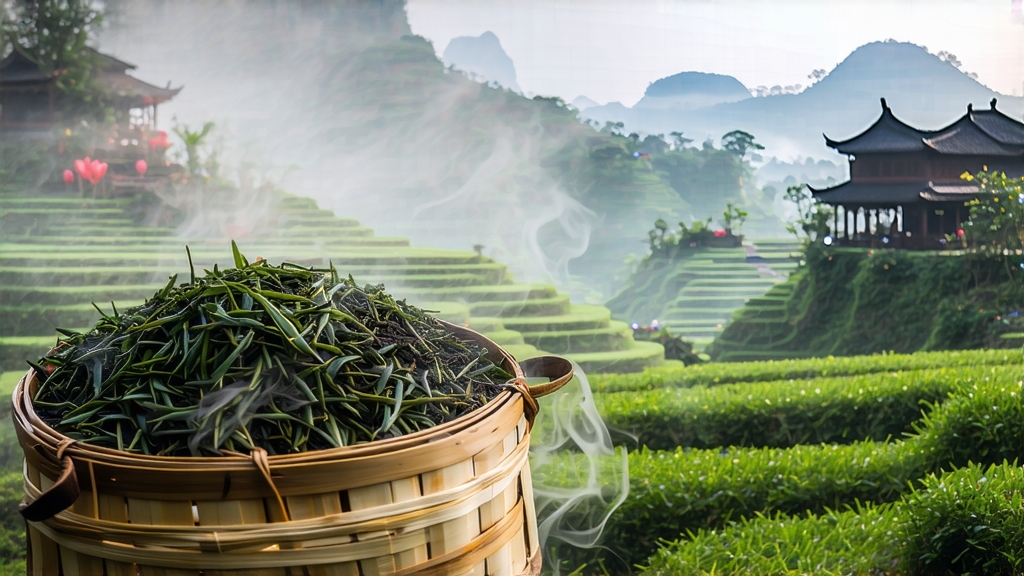
Tucked away in the humid, karst-pocked mountains of southern China’s Guangxi Zhuang Autonomous Region, Liu Bao tea has spent four centuries quietly perfecting the art of microbial alchemy. To most Western drinkers “dark tea” still means Shou Pu-erh, yet Liu Bao is the older, subtler sibling—an heirloom whose flavour carries the echo of camphor forests, horse caravans and the slow breathing of bamboo baskets. This article invites the international tea lover to discover a tea that was once ballast on the Tea-Horse Road, currency for dockworkers in Hong Kong, and is now re-emerging as one of the most cellar-worthy beverages on earth.
-
A leaf born from exile
The name Liu Bao simply means “Six Forts,” a cluster of hamlets outside Wuzhou City where the story begins during the late Ming dynasty. When imperial green-tea tribute quotas bankrupted nearby farmers, growers in the humid, malarial lowlands began to oxidise their summer leaves more heavily so the tea would survive the 2 000-kilometre river journey to Guangzhou. The extra moisture in the hold of bamboo rafts triggered a secondary, post-fermentation; instead of spoiling, the tea arrived darker, smoother, and unexpectedly prized by Cantonese dockers who found it settled stomachs soured by river water. By 1702 the Qing court had registered Liu Bao as “Liang Cha” (cooling tea) and shipped it to Southeast Asia where tin miners in Malaya would later swear it prevented beriberi. Thus a bureaucratic accident became a style. -
From bush to brown paper
Liu Bao belongs to the large-leaf Camellia sinensis var. assamica population that also birthed Pu-erh, but the terroir is different: red lateritic soil shot through with granite, 1 600 mm of rain a year, and a subtropical monsoon that perfumes every tea shed with wild camphor laurel. The picking standard is one bud with three or four leaves—mature, cellulose-rich material that feeds microbes during the long post-ferment. After plucking, the leaves are carried in bamboo baskets down mountain paths so narrow that mules refuse to tread them; the slight bruising en route starts enzymatic oxidation before the leaves even reach the factory. -
The craft: where sun, steam and microbes conspire
Traditional Liu Bao is made in six stages that straddle green-tea killing and microbial invitation.
a. Solar withering: leaves are spread on split-bamboo racks for three to four hours until the edges feel like soft leather.
b. Indoor piling: semi-wilted leaves are heaped 30 cm deep and covered with wet jute; the pile hits 42 °C in forty minutes, fixing a golden amber liquor and beginning non-enzymatic browning.
c. Wok firing: a 280 °C, 90-second “kill-green” arrests polyphenol oxidase but leaves spores of Bacillus subtilis and Aspergillus niger clinging to the leaf surface.
d. Rolling: the hot leaves are twisted into tight cords that will later trap humidity inside the brick.
e. Steam softening & basket press: the semi-dried tea is re-steamed, packed into 40 kg bamboo baskets lined with wild taro leaves, and compressed by a man who walks barefoot on top, turning the bundle into a dense log. The taro leaf alkalinity buffers acids and imparts a faint petrichor note.
f. Wet-pile post-fermentation: the basket is wheeled into an underground cave—constant 26 °C, 85 % RH—for 35–50 days. Workers turn the pile every five days, sprinkling river water rich in lactobacilli. When the core temperature peaks at 55 °C the mass is restacked, allowing oxygen to re-enter and colour to shift from russet to coffee-black.
After cave ageing the tea is dried with charcoal embers, then moved to a riverside warehouse where it spends at least three years “breathing” monsoon air through bamboo slats. Vintage lots are sometimes re-basketed every decade, creating concentric rings of leaf that recall tree growth and allowing micro-aeration that deepens complexity without ever becoming musty.
- Grades and time signatures
Unlike Pu-erh’s raw vs. ripe dichotomy, Liu Bao is always post-fermented